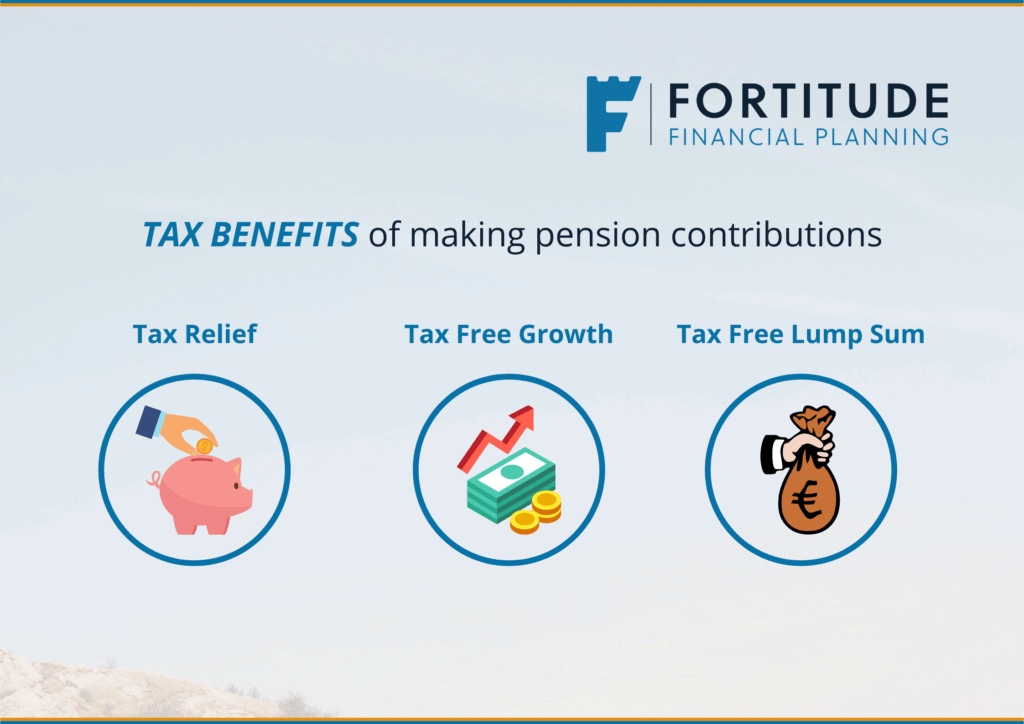Tax and Pensions.
Not the most invigorating subjects.
However, as boring as they appear, they’re very important.
Fact, no one likes paying tax.
Also fact, no one likes paying too much tax.
In the grand scheme of an individuals financial plan, tax minimization and retirement planning are key components.
Due to the tax advantages and benefits available with a pension, both go hand in hand.
Before we get into the tax benefits and advantages, let us first consider why everyone needs a private pension.
Schedule Your No Obligation Chat
Why do we need a private pension?
The state pension (contributory) in Ireland is €13,171 per annum (or €253 per week).
That’s if you qualify for the full state pension.
If you don’t qualify for the full state pension that could be reduced.
For the purpose of this, we will assume you are entitled to the full state pension.
Let’s assume you retire on a final salary of €50,000 and this is replaced in retirement solely by the state pension.
When you stop working that’s a reduction of 75% on your income you will receive.

However, your expenses in retirement, even with a cleared mortgage, will not reduce by the equivalent %.
Every day then becomes a Saturday and a Sunday.
You’re eating at home every day, more trips away, more time to fill.
The aim of the state pension is to cover the basics of living. It won’t provide much more than that.
If you want to live a comfortable life in retirement it’s imperative that you make additional pension provision.
Furthermore, there are significant tax advantages available to help you with this.
The Government do not want people relying on the state pension, therefore provide these tax breaks.
A pension is the most tax-efficient vehicle available to us in our financial planning.
Pension contributions allow you to save for your future but also reduce your tax bill.
Another issue as to why we require a private pension is the sustainability of the current state pension.
Currently payable from age 66, it was previously pushed out to 68.
Our state pension is generous compared to other countries. In the UK it is only £137 per week!
How long the Government can sustain our level of state pension is anyone’s guess.
If you don’t want to have to continue to work to age 66 and likely later, then it’s imperative you make alternative provisions.
What is a pension?
A pension scheme, simply put, is a long term tax-efficient savings account.
The Tax Benefits of a Pension
When it comes to the tax benefits and advantages of a pension, there are three main elements.
- Tax relief on your contributions
- Tax-free investment growth
- A tax-free lump sum at retirement
Tax relief on your contributions
Unlike a regular savings account, pension contributions qualify for tax relief.
The rate of relief you receive is at your rate of income tax.
So, if you pay 20% income tax, you get 20% relief. If you pay 40% income tax, you get 40% relief.
There is no relief for PRSI or USC.
Revenue essentially covers 20% or 40% of your contributions for you, reducing the net cost to you of the pension contribution.

Tax-free investment growth
When invested, your pension fund grows tax-free.
There is no Capital Gains Tax (CGT), Exit Tax, Income Tax or DIRT on your pension fund.
As long as your pension is invested, no tax is payable on the growth.
So if you kick off your pension in your 30’s, you can benefit of over 30 years worth of tax free investment growth.

Tax-free lump sum
When you retire, you are entitled to draw a tax free lump sum from your pension.
This is generally 25% of your overall fund value.
So, if you accumulate a fund of €400,000, you will receive €100,000 as a tax-free lump sum.
There is a cap on the tax-free lump sum available, this is €200,000.
To maximise your tax free lump sum you require a pension fund of €800,000 (€800,000 x 25% = €200,000).
If you are a member of an Occupational Pension Scheme via your employer, there may be an alternative method to the lump sum calculation.
This is based on your years of service and final salary with your employer.
For now, to keep it simple, we will stick with the 25% of your fund value.
Contribution Tax Relief Example
Here, we will outline how the tax relief on contributions works.
Providing you with a breakdown of the gross and net amounts available.
|
20% Tax Bracket |
40% Tax Bracket |
|
| Pension Contribution |
€300 |
€300 |
| Tax Relief Available |
€60 |
€120 |
| Net Cost To You |
€240 |
€180 |
| Total Invested in Pension |
€300 |
€300 |
The same concept can be applied to any level of contribution, both monetary or a % of salary.
If you would like us to calculate your gross and net amounts, let us know.
Maximum Allowable Pension Contributions
Revenue applies a maximum allowable limit to pension contributions that can qualify for the benefit of tax relief.
This is age-related and the younger you are the lower the limit.
As you get older, the limits increase.
This is because it’s expected as we get older we’ll have more disposable income due to potentially higher salaries and less financial commitments.
|
Age attained in the tax year |
Maximum allowable contribution (% of earnings) |
| Under 30 |
15% |
|
30 – 39 |
20% |
|
40 – 49 |
25% |
| 50 – 54 |
30% |
| 55 – 59 |
35% |
| 60 and over |
40% |
Important to note for contributions there is a salary cap of €115,000.
So if you earn more than €115,000 the maximum allowable % is applied to €115,000.
What is also important to note, if you are a member of your employers PRSA, any employer contribution also contribute to this %.
However, if you are a member of an employers occupational pension scheme, employer contributions do not contribute to your maximum allowable.
One of many strange quirks in the Irish pension system!
Pension Jargon – Additional Voluntary Contributions (AVC’s)
What are AVC’s?
If you are a member of your employers pension scheme, you will generally receive an employer coontribution.
Let’s say 5% of salary.
Let us also say you contribute 5% of your salary to match what the employer contributes.
An AVC is anything you pay voluntary over and above your 5% you are paying to match and receive the employers contribution.

At Retirement
So, you’ve benefitted from the tax relief and the tax-free growth and you want to retire, what happens?
We outlined above you are entitled to a tax-free lump sum, generally 25% of the fund value.
You should always maximise your tax-free lump sum.
It’s the only opportunity you will get to draw tax free money from your pension.
With the balance of your fund, you generally have one of two options:
- Invest in an Approved Retirement Fund (ARF) or
- Purchase an Annuity
You can learn more about these options by clicking here.
Any income you draw from your ARF or Annuity is then assessable for tax.
But, in retirement, it’s likely you’ll be paying a lower overall effective rate of tax in retirement than you do pre-retirement.
Summary
To summarise, why do we need a private pension?
The state pension is only designed to cover basic living needs, if we want a comfortable retirement, we need more.
Additionally, questions continue to remain around the sustainability of the state pension.
Is it sustainable in it’s current form?
Will it be pushed back to be received at a later age?
And will it even be there for the younger demographic in future?
Various tax breaks are provided by the Government to assist us in funding our retirement.
- Tax relief at our rate of income tax is available on our pension contributions
- Tax-free investment growth on our pension funds
- A tax-free lump sum is available to us when we retire
And we carry a personal responsibility to fund our own retirement.
If we want to retire comfortably, not just get by, it’s our responsibility to make provision for this.
Schedule Your Pension Consultation
How we help
At Fortitude Financial Planning we specialise in helping our clients plan for retirement.
And this is the retirement they want, not the requirement the state pension would force them into.
We can approach this in one of two ways with you:
- We will carry out a pension only review with you focusing purely on your pension arrangements or
- Factor your retirement planning into an overall cohesive financial plan for you
With a pension only review, we will review what you have, what your paying in fees, projections and recommend any improvements.
And we will ensure you are set up in the correct pension structure for your own individual (or your business’) circumstances.
As part of an overall financial plan, we will look at where you currently allocate resources.
We will prioritise your objectives and allocate your resources accordingly to your retirement planning.
Like the pension only review, we will also review what you have, what your paying in fees, projections and recommend any improvements.
If you would like to schedule an initial discussion, request a callback.
Alternatively, you can book straight into our diary here.
Otherwise, give me a call on 086 0080 756 or drop us an email, info@fortitudefp.ie.
We have over 30 articles we’ve written on various subjects and they can be accessed here.
A wealth of free information covering all aspects of saving, investing, financial planning, protection and pension advice.


Francis McTaggart CFP® SIA RPA QFA
These blog posts are intended for information purposes only and should not be interpreted as financial advice.
You should always engage the services of a fully qualified financial planner before entering any financial contract.
To discuss engaging the services of Fortitude Financial Planning please email us at info@fortitudefp.ie.
Fortitude Financial Planning Ltd will not be held responsible for any actions taken as a result of reading these blog posts.




 Production
Production